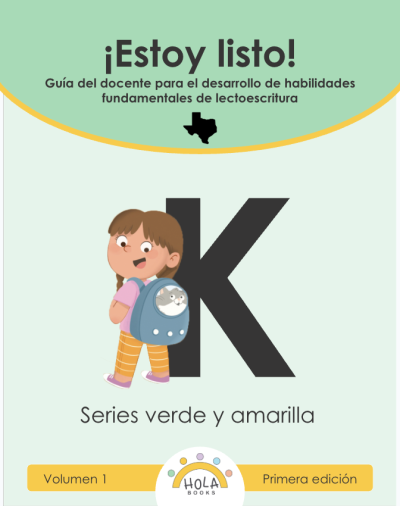Evaluation for 5.E.1d
Materials provide a variety of activities and/or resources in Spanish to support students in decoding and encoding words that include taught syllable correlations, both in isolation (e.g., word lists) and in authentic Spanish decodable connected text that builds on previous instruction (e.g., within sentences or decodable texts). (S)
The materials provide a variety of activities and resources in Spanish to support students in decoding words with taught syllable correlations both in isolation and in connected text. For example, in the ¡Estamos listos! Práctica adicional resource, students decode words in isolation using Elkonin boxes (e.g., te-la, Pe-pe), and read sentences such as "Papá amasa la masa." The materials include authentic decodable texts in Spanish that build on previous instruction. In the Guía del docente, Semana 29, Días 1–2, the teacher reviews and introduces new skills (e.g., digraphs qu, ll), and through the decodable text "El monopatín," students decode words with taught syllables, such as Henrique and rodilleras. To support students in encoding words with taught syllable patterns, the materials provide a variety of activities and resources in Spanish for both isolated practice and authentic decodable connected text. The Presentación de fonética offers daily opportunities for encoding. After decoding words with "sílabas trabadas con l," students read decodable word lists (e.g., flota, blusa, playa), and practice encoding these patterns during a dictado with words like clima, blusa, and playa. Likewise, in Semana 28, Día 4, following decoding of words containing q, ll, and h, students read word lists (e.g., hizo, llegar, Chiquis), and encode sentences during "Dictado" activities, such as Hace tanto calor, reinforcing the sound-letter correspondences. In Hola Books, ¡Estoy listo! Kínder, students first decode isolated syllables and CVCV words like mamá, papá, mapa, and puma in Mi cuaderno de práctica following explicit instruction. "Dictado" sections offer teachers word lists aligned to weekly syllable patterns (e.g., papa, pelo, loma, casa), guiding modeling and scaffolding before applying skills in connected text. The program also includes decodable texts to reinforce syllable decoding in context. For example, in Week 14, Day 3, after syllable instruction (e.g., lu, sa, le, cu), teachers guide blending practice with projected syllables. The next day, during Lectura compartida, students read the decodable book ¿Dónde está mamá?, blending syllables into words like luna and cuna, and reading the full text aloud using previously taught syllables and words.



